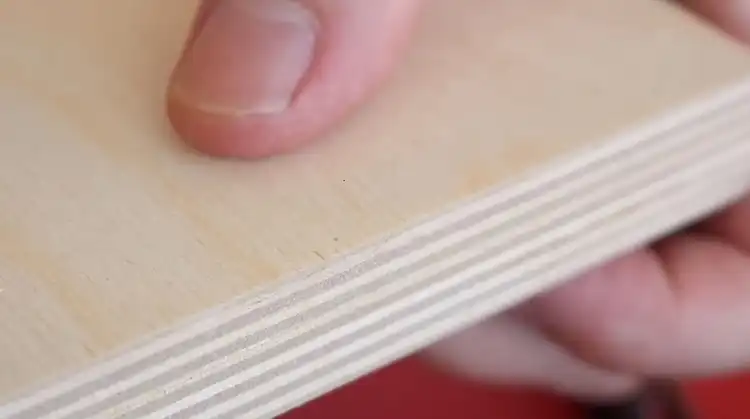Is Birch Plywood Good For Cabinets?

When it comes to choosing materials for kitchen cabinets, birch plywood has emerged as a popular option for many homeowners and contractors. But is birch plywood really good for cabinets?
Let’s dive into the details and explore why this versatile material might be the perfect choice for your next kitchen renovation project.
Birch plywood is a durable hardwood that offers an excellent balance of strength, aesthetics, and affordability for cabinet construction.
With its high tensile strength and resistance to wear and tear, birch plywood can withstand the rigors of daily kitchen use while providing a beautiful, natural wood appearance.
Its light brown or golden honey color complements various kitchen styles, from farmhouse to contemporary designs.
While birch plywood has many advantages, it’s essential to compare it to other popular cabinet materials like maple, MDF, and particle board to make an informed decision.
Understanding Birch Plywood for Cabinets

Before we delve deeper into the suitability of birch plywood for cabinets, let’s first understand what it is and its key properties.
What Is Birch Plywood?
Birch plywood is a type of hardwood plywood made from layers of birch wood veneer. It’s sourced primarily from forests in Canada and the Northeastern United States.
The layers are stacked with the grain direction alternating and bonded together with strong adhesives, creating a stable and durable sheet material.
Properties Of Birch Plywood
Birch plywood boasts several characteristics that make it an attractive option for cabinetry:
- Strength: It has a high tensile strength, making it resistant to warping and bending.
- Appearance: Birch has a light brown or golden honey color with a subtle, straight grain pattern.
- Texture: The surface of birch plywood can have a slightly rough or papery texture.
- Density: It has a medium density compared to other hardwoods.
These properties contribute to birch plywood’s popularity in cabinet making and other woodworking applications.
Advantages of Using Birch Plywood for Cabinets
Now that we understand what birch plywood is, let’s explore the benefits it offers for cabinet construction.
Durability And Strength
One of the primary reasons birch plywood is favored for cabinets is its durability. The layered construction and hardwood composition make it resistant to everyday wear and tear.
Birch plywood can withstand the weight of dishes, cookware, and other kitchen items without sagging or breaking. Its strength also means it can hold screws and other fasteners securely, ensuring your cabinets remain sturdy for years to come.
Aesthetic Appeal
Birch plywood offers a clean, natural look that can enhance various kitchen styles. Its light color and subtle grain pattern provide a neutral backdrop that can be easily customized with stains or paints.
Whether you’re aiming for a modern, minimalist look or a more traditional aesthetic, birch plywood can adapt to your design preferences.
Cost-Effectiveness
Compared to some other hardwoods used in cabinetry, birch plywood is often more budget-friendly. It provides many of the benefits of more expensive woods at a lower cost, making it an attractive option for those looking to balance quality and affordability in their kitchen renovation.
Comparing Birch to Other Cabinet Materials
To truly understand if birch plywood is the right choice for your cabinets, it’s helpful to compare it to other popular materials.
Birch vs. Maple
Maple is another popular hardwood used in cabinetry. Let’s see how it compares to birch:
Appearance differences
Both birch and maple have a light color and subtle grain, but there are slight differences. Maple tends to have a slightly redder hue, while birch leans more towards a yellowish tone. Maple often has a smoother surface compared to birch’s rougher texture.
Strength comparison
While both are strong hardwoods, maple generally ranks higher on the Janka hardness scale. On this scale, hard maple ranges from 1400-1500, while birch lands around 1200-1300. This means maple may be slightly more resistant to dents and scratches.
Finishing options
Both woods take stains and paints well, but there are some differences:
Stains: Birch can sometimes absorb stains unevenly, leading to a blotchy appearance, especially with darker stains. Maple tends to take stains more evenly.
Paints: Both are considered paint-grade hardwoods due to their smooth grain. However, like all solid woods, both are susceptible to expansion and contraction, which can lead to paint cracking over time.
Cost considerations
Typically, maple is more expensive than birch. However, prices can vary depending on the grade of wood and market conditions. Some high-quality birch may be comparable in price to maple.
Birch vs. MDF and Particle Board
Medium-density fiberboard (MDF) and particle board are engineered wood products often used in cabinetry. Here’s how they compare to birch plywood:
Strength and durability: Birch plywood is significantly stronger and more durable than MDF or particle board. It’s less likely to sag or break under weight.
Moisture resistance: Birch plywood is more resistant to moisture than MDF or particle board, which can swell and deteriorate when exposed to water.
Screw holding ability: Birch plywood holds screws and other fasteners much better than MDF or particle board.
Cost: MDF and particle board are generally less expensive than birch plywood.
Finishing: MDF takes paint very well and is less prone to cracking, making it a good choice for painted cabinets. However, it doesn’t offer the natural wood look that birch plywood can provide.
Considerations When Using Birch Plywood for Cabinets
While birch plywood offers many advantages, there are some factors to keep in mind when using it for cabinets.
Finishing And Staining
As mentioned earlier, birch can sometimes absorb stains unevenly, especially darker stains. To achieve the best results:
- Use a wood conditioner before staining to promote even absorption.
- Consider lighter stains or clear finishes to showcase the natural beauty of the wood.
- If painting, use a good primer to ensure even coverage.
Installation Requirements
Birch plywood cabinets should be installed by a professional to ensure proper fitting and longevity. The installation process typically involves:
- Cutting the plywood to size
- Assembling the cabinet boxes
- Attaching face frames (if using a face frame design)
- Installing doors and hardware
Maintenance And Care
To keep your birch plywood cabinets looking their best:
- Clean regularly with a soft cloth and mild soap solution.
- Avoid excessive moisture exposure.
- Use coasters or mats under appliances to prevent scratches.
- Periodically check and tighten hardware as needed.
Environmental Impact of Birch Plywood
For environmentally conscious homeowners, the sustainability of cabinet materials is an important consideration.
Birch trees grow relatively quickly and are abundant in North America, making birch plywood a more sustainable option compared to some exotic hardwoods.
However, it’s always a good idea to look for plywood certified by organizations like the Forest Stewardship Council (FSC) or Program for Endorsement of Forest Certification (PEFC) to ensure it comes from responsibly managed forests.
Final Words
In conclusion, birch plywood is indeed a good choice for cabinets, offering a balance of durability, aesthetics, and affordability.
Its strength and resistance to wear make it suitable for the demands of kitchen use, while its natural beauty can enhance various design styles.
While it may not be as hard as maple or as paint-friendly as MDF, birch plywood’s versatility and cost-effectiveness make it an attractive option for many homeowners.
By understanding its properties and how to properly finish and maintain it, you can create beautiful, long-lasting cabinets that will be the centerpiece of your kitchen for years to come.
Frequently Asked Questions
1. Is Birch A Good Wood For Kitchen Cabinets?
Yes, birch is an excellent hardwood often used in making kitchen cabinetry. It is known for its durability, fine grain, and smooth texture, making it ideal for painting or staining. Birch is also relatively affordable compared to other hardwoods, providing a cost-effective option for high-quality kitchen cabinets.
2. Is Birch Or Maple Plywood Better For Cabinets?
Maple plywood tends to be harder and more durable than birch plywood, making it the better choice for cabinets in terms of strength and longevity. Maple also has a slightly finer grain, which can provide a smoother finish when stained or painted. However, birch plywood is still a good option and is often more budget-friendly.
3. What Are The Disadvantages Of Birch Plywood?
One of the main disadvantages of birch plywood is that birch heartwood is quite soft, making it susceptible to pests and poor termite resistance if not properly treated. Additionally, birch can be more prone to warping if not carefully dried and maintained.
4. What Is Stronger, Birch Plywood Or MDF?
Baltic Birch plywood is considered stronger than MDF (Medium-Density Fiberboard). Birch plywood has a high strength-to-weight ratio and excellent durability, making it suitable for heavy-duty applications like cabinetry. MDF, while smooth and stable, is not as strong or resistant to impact as birch plywood.
5. What Is The Most Popular Wood For Kitchen Cabinets?
The most popular woods for kitchen cabinets include solid oak, beech, cherry, maple, and walnut. These hardwoods are favored for their durability, natural beauty, and the variety of finishes they offer, allowing homeowners to choose a style that fits their kitchen’s aesthetic.





